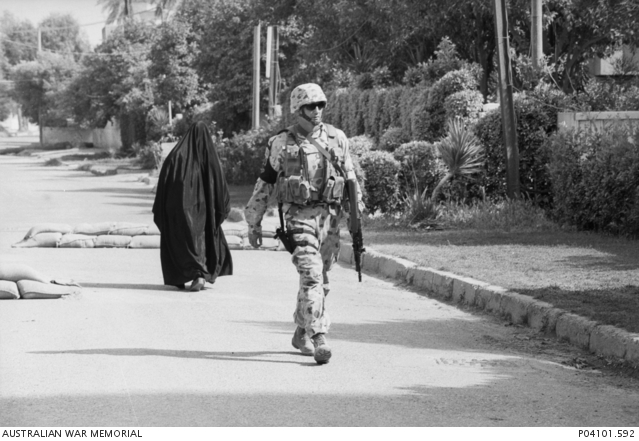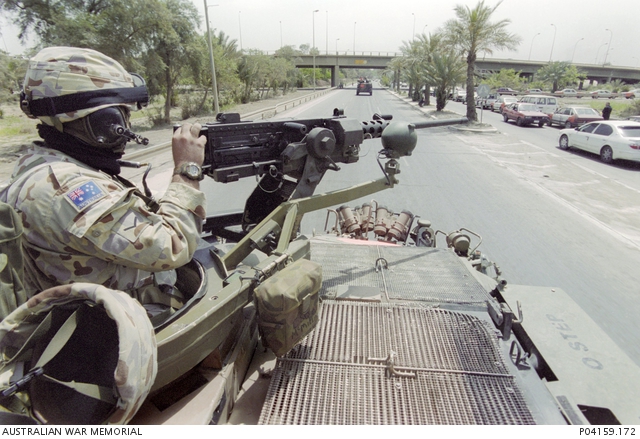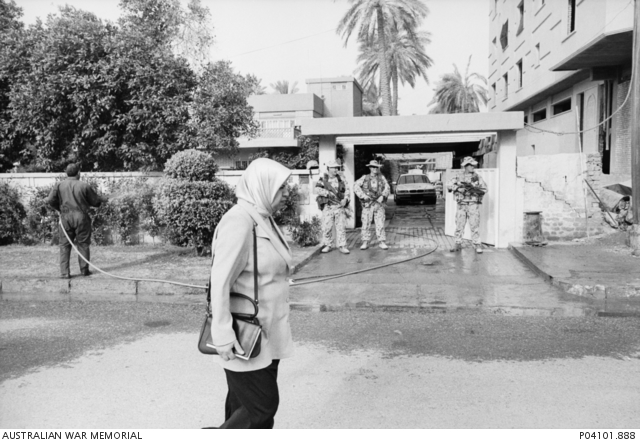Australians in Iraq 2003: Australians in Baghdad
- War in Iraq
- Political debate at home
- The RAN in the Persian Gulf
- RAN clearance divers
- The SAS in Iraq
- Special forces group
- The RAAF in Iraq
- Australians in Baghdad
- Current situation
- Official war artists
Australians in Baghdad
After the end of the main fighting, about 1,000 Australians remained in the Middle East. The Australian national headquarters set up alongside the coalition land headquarters in an unfinished presidential palace on the outskirts of Baghdad. The palace was opulent, with stone carvings and domed ceilings, but it had also been damaged by coalition bombing and by looters.
In Baghdad the troops found a population attempting to reconstruct their lives amid the rubble. Many appeared to show great relief at the overthrow of the dictator, while some remained actively loyal to the regime. The streets were not safe, and most of the Australians were confined to their compound. The intense heat of the Iraqi summer made working during the day difficult, even dangerous. The nights were punctuated with the sounds of small-arms fire, explosions, and American helicopters on the prowl.
In May 2003 a RAAF detachment took over the task of air traffic control at the run-down and war-damaged Baghdad International Airport. Initially, all communications with aircraft went through Australian radio systems, while they waited for replacement equipment to be installed. Power and water were unreliable until support troops began work to improve facilities.
An Australian light-armoured ASLAV-25 reconnaissance vehicle at a checkpoint in Baghdad, in May 2003
An Australian light-armoured ASLAV-25 reconnaissance vehicle at a checkpoint in Baghdad, in May 2003.
On patrol in a Baghdad street on 3 May 2003, Lance Corporal Jason Nuske of the 2nd Cavalry Regiment mans a .50-calibre machine-gun mounted on an Australian ASLAV light-armoured vehicle.
Lance Corporal Jason Nuske of the 2nd Cavalry Regiment surveys the streets of Baghdad from an Australian ASLAV-25 reconnaissance vehicle. He is wielding an FN Browning M2 .50-calibre machinegun
In May 2003, Signalman Glenn Parker inspects the damage caused to one of Saddam Hussein’s palaces in Baghdad by an American 2,000-lb (900-kilogram) Penetrator bomb with a JDAM (Joint Direct Attack Munition) guidance system. The war saw unprecedented use of guided “smart” bombs.
An Australian ASLAV-25 negotiating roadblock chicanes in front of the former Australian Embassy residence, Baghdad, in May 2003. The 8-wheeled ASLAV is a mobile amphibious vehicle, especially suited to reconnaissance and surveillance operations
After the war, in May 2003, an Iraqi woman passes the former Australian Embassy residence in Baghdad.
After the war, in May 2003, an Iraqi woman passes the former Australian Embassy residence in Baghdad.
While the Iraqi people suffered the effects of UN sanctions during the 1990s, Saddam Hussein and his family continued to build opulent palaces, with elaborate gardens, waterfalls, and luxurious interior fittings. By 2003, there were an estimated 78 palaces around the country.
A formal dining area within the Presidential Palace North, near Baghdad airport, the building in which the Australian National Headquarters was based after the war.
Fruit sellers are plying their wares along the side of a Baghdad road as an Australian ASLAV light-armoured vehicle drives past, in May 2003. The ASLAVs, operated by the 2nd Cavalry Regiment, had the task of protecting Australian military and diplomatic staff in Baghdad.
Iraqi men walk along the street past the former Australian Embassy residence in Baghdad, in May 2003. Behind them is an Australian ASLAV light armoured vehicle, operated by the 2nd Cavalry Regiment, which had the task of protecting Australian military and diplomatic staff.
A morning briefing takes place, in May 2003, at the Australian National Headquarters in Baghdad an incongruous setting in an ornate room in one of Saddam Hussein’s former palaces.
An Australian soldier of the 2nd Battalion, Royal Australian Regiment (2RAR), sits on a box shaving. The unit was based in an unfinished 13-floor hotel in Baghdad.
Two Australian soldiers from the 2nd Battalion, Royal Australian Regiment (2RAR), take a break in their quarters in an unfinished hotel, in May 2003. The soldier on the left is cleaning his rifle
Captain Phil Pyke from the Joint Public Affairs Unit on night piquet duty at the former Australian Embassy residence in Baghdad. The photograph was taken through night-vision goggles.
An eerie view of Baghdad on 13 May 2003, seen through night-vision goggles. The picture was taken from the accommodation area at the Australian National Headquarters, located near Baghdad airport in one of Saddam Hussein’s former palaces.
















